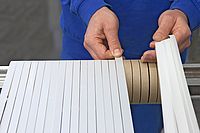Schneideservice für Rollen und Bogen
Glass-fibre tape cutting with none other than Lösing GmbH
If you work with or distribute glass-fibre tape, you need a competent partner when it comes to cutting the material. Here at Lösing GmbH – the cutting service for rolls and sheets, we specialise in cutting glass-fibre fabric. With as many as 12 CNC-controlled machines at our disposal, we are able to cut your glass-fibre fabric with an extremely low tolerance. What’s more, we also pride ourselves on our excellent results, optimum service and a consistently friendly approach.
So what is glass-fibre tape?
The way glass fibres are processed depends entirely on the desired material. Mechanical applications mostly require glass fibres to be processed in non-wovens, as roving or as fabric. Profiles, on the other hand, come complete with glass fibres running in one direction. The general advantages of glass fibre fabrics are that they have a low tendency to creep while also being highly resistant to moisture. In the manufacturing process, glass fibres are first coated with a sizing agent to protect them from damage. This sizing serves as a lubricant in the production of glass fibre fabric, but is chemically removed after weaving to leave a pure glass-fibre fabric. The glass-fibre fabric is firmly bonded to the plastic in the finishing process, which involves the application of an adhesion promoter that acts like a synthetic resin.
Both glass-fibre fabrics and plastic reinforced with glass fibres are particularly robust. What’s more, misalignments and length defects of the glass fibre arise significantly less compared to the volume of the material. This results in the entire material being stronger and means it now has a high level of tensile stretch. Plastic equipped with glass fibre fabric maintains its flexibility and guarantees elastic tensile strength. Glass-fibre fabric is used especially for components that have a high strength and, at the same time, a low weight.
Cutting glass-fibre fabric
If our customers would like us to cut glass-fibre fabric into rolls or tapes, we use the re-rolling process. At the beginning of the cutting process, the webs are first completely unrolled before being cut with an upper and lower blade. In a final step, we rewind the rolls and tapes once the cutting process is complete. The cutting service is based on CNC control, which guarantees both a constant width and a high level of cutting quality. Our services also include a re-rolling process for cut widths of 6.35, 12, 25 and 75 millimetres.
Cutting glass-fibre fabric into shapes and strips
If our customers require us to cut strips or shapes, we start by cutting larger sections out of the glass fibre fabric and then trim these until they are the correct size in the next step. This is a process we call roll-to-sheet or roll-to-shape cutting, and involves the use of upper and lower blades.
Winding after cutting glass-fibre fabric
Of course, it goes without saying that our cutting service also includes winding once the cutting is complete. We generally wind the tapes on cardboard cores with an inner diameter of 3 or 6 inches. Each strip is given its own cardboard core to provide a greater level of transparency and make it easier to recycle the material down the line. As a valued customer, if you would like to specify different dimensions for the cardboard cores then we will of course be more than happy to meet your requirements.
Count on Lösing GmbH to cut your glass-fibre fabric
Contact us today so that we can start cutting glass-fibre fabric for you, too. When it comes to guaranteeing the best possible results, you can always count on our experience, our knowledge and our CNC-controlled systems. We cut glass fibre fabrics with maximum precision and guarantee a tolerance of just ±0.1 millimetres.
So when can we start cutting your glass-fibre tape?













